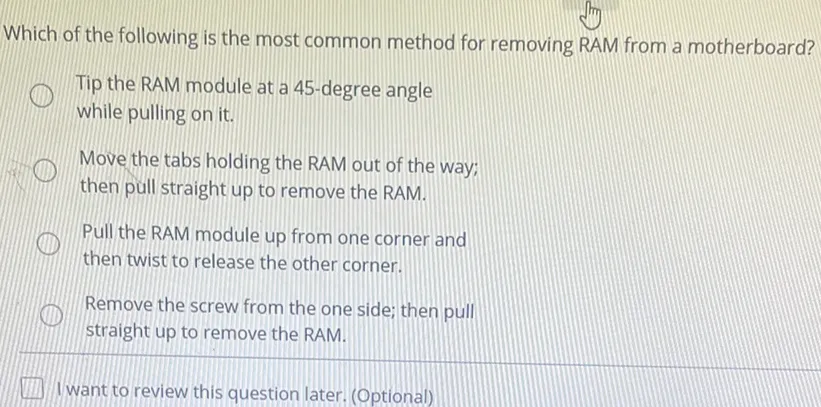Homework Help: Questions and Answers: Which of the following is the most common method for removing RAM from a motherboard?

a) Tip the RAM module at a 45 -degree angle while pulling on it.
b) Move the tabs holding the RAM out of the way; then pull straight up to remove the RAM.
c) Pull the RAM module up from one corner and then twist to release the other corner.
d) Remove the screw from the one side; then pull straight up to remove the RAM.
Answer:
First, let’s understand RAM installation in motherboards:
- RAM modules are typically held in place by small clips or tabs on either end of the RAM slot.
- RAM is not usually secured with screws.
- RAM modules are designed to be inserted and removed straight up and down, not at an angle.
Now, let’s analysis each given option to identify the correct method for removing RAM from a motherboard.
Given Options: Step by Step Answering
a) Tip the RAM module at a 45-degree angle while pulling on it
- This method is commonly used for certain types of components like M.2 SSDs, but RAM modules are not removed by tipping them at an angle. RAM is typically locked into place with retaining clips, so this method is incorrect.
b) Move the tabs holding the RAM out of the way; then pull straight up to remove the RAM
- This is the most common method. RAM sticks are held in place by clips/tabs at both ends, which need to be moved aside before pulling the RAM straight up. This is the correct process for removing RAM from a motherboard.
c) Pull the RAM module up from one corner and then twist to release the other corner
- Twisting or pulling from one corner could damage the RAM or the motherboard. This is not a correct or safe method.
d) Remove the screw from one side; then pull straight up to remove the RAM
- RAM sticks do not have screws securing them to the motherboard. This method does not apply to RAM modules.
Final Answer
Based on the above analysis, the correct answer is:
b) Move the tabs holding the RAM out of the way; then pull straight up to remove the RAM.
Learn More: Homework Help
Q. Why do IoT devices pose a greater risk than other computing devices on a network?
Q. It consists of online users who signed up for membership on an e-mail list management website.